Barbara L. Coffey
Historic Nantucket, late Fall 2024, Volume 74, No. 3
Nantucket Historical Association
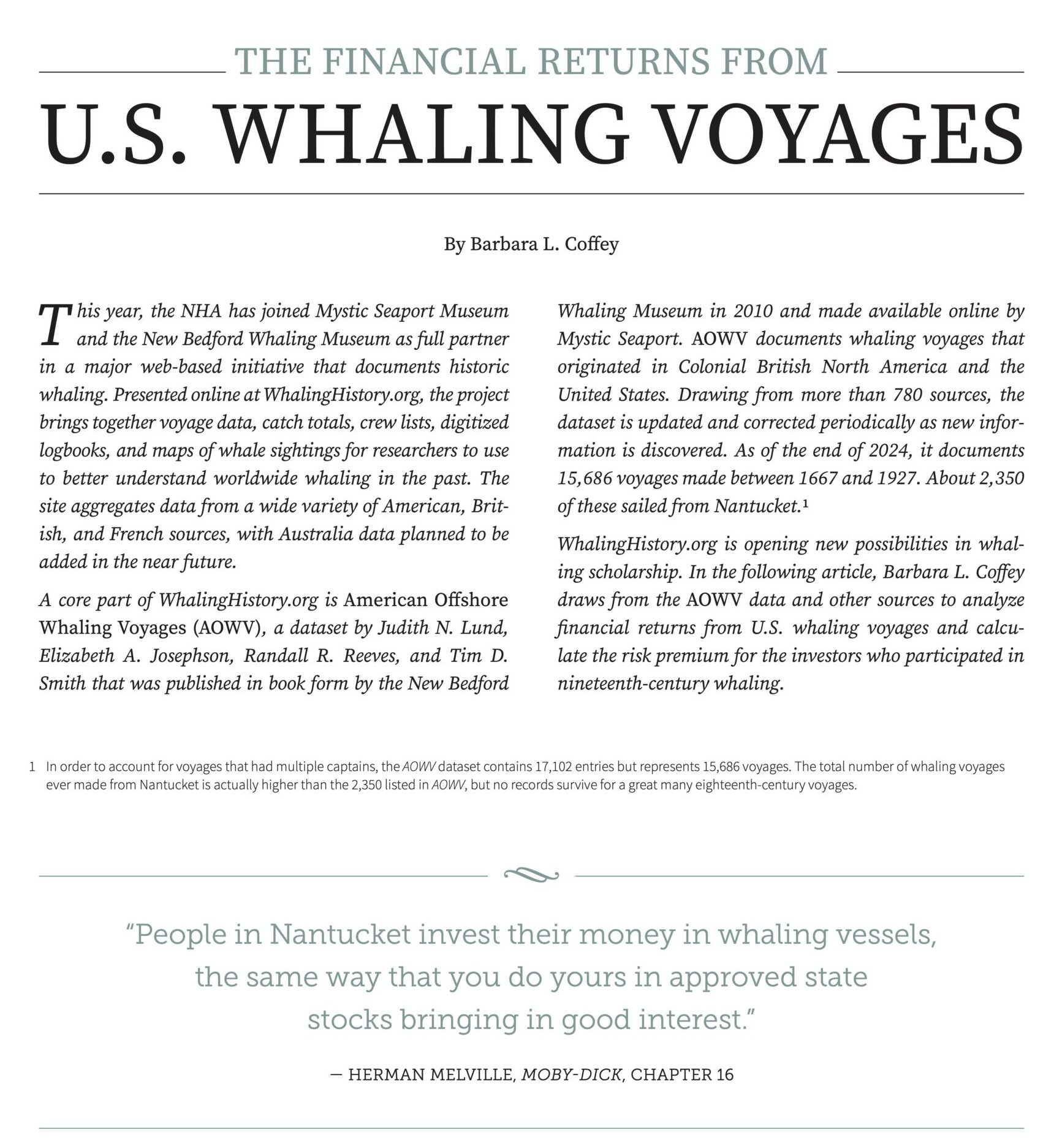
Download article →
Barbara L. Coffey is a librarian at Monmouth University. Previously, she was a research analyst on Wall Street.
Connecting All Things Whaling
Barbara L. Coffey
Historic Nantucket, late Fall 2024, Volume 74, No. 3
Nantucket Historical Association

Download article →
Barbara L. Coffey is a librarian at Monmouth University. Previously, she was a research analyst on Wall Street.
If you’re not sure where to begin, use the Search box in the banner at the top of any page. Enter a person’s name, a vessel name, a year, or any other words of interest and click the ‘magnifying glass’ icon. This site Search function knows about all of the databases and all of the web pages on the Whaling History website. It will return any results it finds from each one in a separate tab.
Information about using the Search function will appear below your search results. View the Search documentation here → (when you get there, click on the “View search help” button.)
The data map below shows the entities represented in the databases and the main connections among them to help you visualize what is going on in your search results. Click on the data map to view or print a PDF version.
When the the main site search is not specific or flexible enough for your needs, use the data viewers. Each database has its own data viewer—a tabular display window to interact with the data—and all of the data viewers share a common set of features.
The data viewers are available from the Databases item on the main menu at the top of every page.
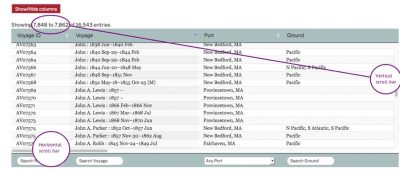
The view displays a scroll bar on the bottom to scroll left-and-right through the available columns. A scroll bar on the right edge scrolls through the records. In the top left, the viewer shows the records currently in the display window. If you have a tablet or other touch screen device, you can also swipe vertically or horizontally to scroll the data.
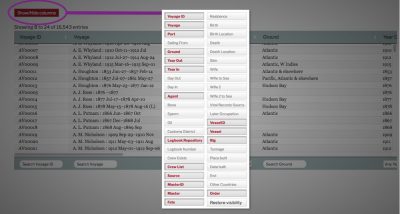
You can choose to hide or show any of the columns in the database. Click the red Show/Hide Columns button in the top left to display all of the column names. Click on a column name to toggle it on or off. Each database has a Columns Definitions page where you can learn more about the content its columns. (Click outside column name box to continue.)
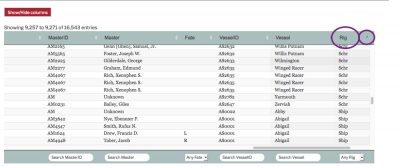
Click on any column heading to sort the database by that column. The triangle to the right of that column name will turn blue to indicate that the column is sorted. Click again on the column heading to reverse the sort order. (The blue triangle will invert.) To add more columns to your sort shift-click on their column headings.
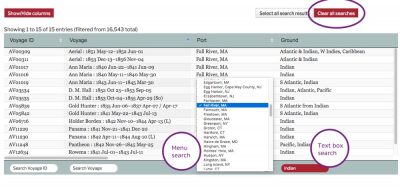
At the top or bottom of each column is a search box. Some columns have a selection menu that will pop up, others have a free form text box. Text searches are not case sensitive.
Multiple search words are treated as if joined with AND, so choosing “Fall River, MA” with the Port menu and typing “indian” in the Ground search box will result in all voyage records that have Port=”Fall River, MA” AND Ground contains “indian”.
Some of the databases are very large—please be patient, your search results may not appear instantaneously. To clear all active searches, use the red “Clear all searches” button in the top right.
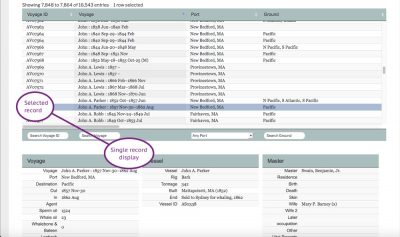
In the Voyages database, click on a single row in the data viewer for a full display of all aspects of the voyage at the bottom of the page.
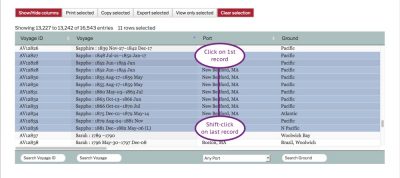 To select more than one row, click on the first row, then add more with shift-click. Depending on your browser and operating system, you may also be able to add individual records using ctrl-click or ⌘-click.
To select more than one row, click on the first row, then add more with shift-click. Depending on your browser and operating system, you may also be able to add individual records using ctrl-click or ⌘-click.
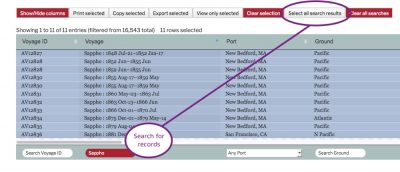
Or, after searching the database you can select the found records by clicking the “Select all search results” button that will appear in the top right. To unselect all selected records, click the red “Clear selection” button.
Printing, copying and export all work with a selection, which may include one or more records. For the examples below we’ve selected all the voyages of the bark Sappho. This selection happens to fit neatly in our data viewer window, but your selection might include many more records than you can view at one time.
The set of columns that you’ve chosen with the “Show/Hide” button will be the columns that appear in your print, copy or export.
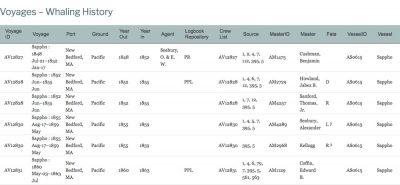 To produce a printable version of the selected records, click on the “Print selected” button in the top left. A new browser window will open with your data in a table. You can then print the page using your browser’s print command. Depending on your operating system, you may also be able to save the output as a PDF file, or email or text it to yourself and others.
To produce a printable version of the selected records, click on the “Print selected” button in the top left. A new browser window will open with your data in a table. You can then print the page using your browser’s print command. Depending on your operating system, you may also be able to save the output as a PDF file, or email or text it to yourself and others.
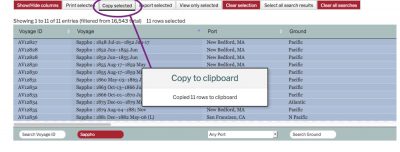 To copy the selected records to your clipboard, click on the “Copy selected” button. A message will appear to tell you that the data has been copied. You can then paste the data into any other application. It is properly formatted so that you can paste directly into a spreadsheet. It will also format neatly in a word processor. If pasted into a plain text editor, the result will be tab-delimited text.
To copy the selected records to your clipboard, click on the “Copy selected” button. A message will appear to tell you that the data has been copied. You can then paste the data into any other application. It is properly formatted so that you can paste directly into a spreadsheet. It will also format neatly in a word processor. If pasted into a plain text editor, the result will be tab-delimited text.
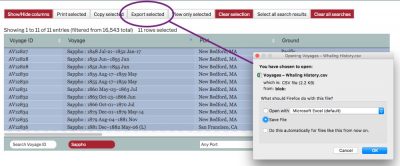
To export your selection as a CSV file, click on the “Export selected” button. Your computer operating system will prompt you to save the data. The resulting file will be comma-delimited and all columns will be wrapped with quotation marks. The first row will contain the column names. A file in this format can be opened in a spreadsheet, or it may be imported into software for managing databases or performing statistical analysis.
Crew lists appear in many different primary sources. American crew lists in WhalingHistory.org have usually come from one of these sources:
Crew lists were supposed to be filed, but sometimes they weren’t. Sometimes the records were later lost. Official crew lists were intended for the protection of American citizens, so they may not carry as much (or any) information about foreign-born crewmen. And, crew lists, like other primary sources, are snapshots in time—if a crew list was submitted before the beginning of a voyage, it will not contain information about crew members who joined the voyage later.
Sometimes the database contains two copies of the same crew list, usually because the original document was transcribed by different people working on different projects years apart. There are often differences in how they interpreted the original handwriting, which leads to very different spellings for some names. We keep both versions to improve the chance that you find the name you are looking for.
See the Crew List Column Definitions.
If you have relevant information from other sources (public sources, family documents, etc.) or you have found a transcription error, write to us using the Contact form.
WhalingHistory.org is a repository for data about whaling. For a general overview of whaling and whaling history, here are some resources to start your exploration. Each of them takes a different approach: a narrative, a collection of artifacts and maps, a timeline, a collection of topics, a map, a work of literature.
An animated visualization of Matthew Maury’s collection of data from logbooks of American whaling voyages. From Data narratives and structural histories: Melville, Maury, and American whaling by Ben Schmidt:
“Data visualizations are like narratives: they suggest interpretations, but don’t require them. A good data visualization, in fact, lets you see things the interpreter might have missed. This should make data visualization especially appealing to historians. Much of the historian’s art is turning dull information into compelling narrative; visualization is useful for us because it suggests new ways of making interesting the stories we’ve been telling all along. In particular: data visualization lets us make historical structures immediately accessible in the same way that narratives have let us do so for stories about individual agents.
“I’ve been looking at the ship’s logs that climatologists digitize because it’s a perfect case of forlorn data that might tell a more interesting story. My post on European shipping gives more of the details about how to make movies from ship’s logs, but this time I want to talk about why, using a new set with about a half-century of American vessels sailing around the world.
“To find something I might more usefully be able to discuss, I went through the biggest source of historical shipping records, the ICOADs collection, and pulled out the very first systematic collection of logbooks ever assembled: Matthew Maury’s collection of American shipping from about 1785 to 1860, assembled mostly before the Civil War.”
Legend: Hunt** = East Greenland (EG), Davis Strait (DS), Newfoundland (NL), Cumberland Gulf (CG)
Note: For additional data, see Scottish Arctic Whaling. In the table below, click on a column heading to sort by that column. Click on an entry in the “Link to Whaling History” column to view voyage data for that vessel.
| Lost | Vessel | Sail/ Steam | Link to Whaling History | Port | Hunt** | Years Whaling | Total Seasons |
|---|---|---|---|---|---|---|---|
| 1751 | Hopeton | s | SS127 | Edinburgh | EG | 1751 | 1 |
| 1756 | Thistle | s | SS264 | Borrowstounness | EG | 1752-6 | 5 |
| 1757 | Prince of Wales | s | SS211 | Edinburgh | EG | 1753-7 | 5 |
| 1758 | Borrowstounness | s | SS035 | Borrowstounness | EG | 1755-8 | 4 |
| 1762 | Hawke | s | SS116 | Anstruther | EG | 1758-62 | 5 |
| 1763 | Edinburgh | s | SS078 | Edinburgh | EG | 1752-63 | 12 |
| 1775 | Oswald | s | SS193 | Borrowstounness | EG | 1755-75 | 21 |
| 1775 | Peggy | s | SS199 | Borrowstounness | EG | 1752-75 | 23 |
| 1777 | Royal Bounty (1) | s | SS235 | Edinburgh | EG | 1752-77 | 26 |
| 1778 | Campbelton | s | SS042 | Edinburgh | EG | 1751-78 | 28 |
| 1782 | Dundee (1) | s | SS068 | Dundee | EG | 1754-82 | 29 |
| 1791 | Neptune | s | SS185 | Edinburgh | EG | 1787-91 | 5 |
| 1792 | Montrose | s | SS181 | Montrose | DS | 1787-92 | 6 |
| 1792 | Princess of Wales (1) | s | SS215 | Dunbar | EG | 1759-92 | 33 |
| 1798 | Blessed Endeavour | s | SS031 | Dunbar | EG | 1753-98 | 44 |
| 1799 | Toy(1) | s | SS259 | Dundee | EG | 1786-99 | 14 |
| 1804 | East Lothian | s | SS074 | Dunbar | EG | 1785-1804 | 19 |
| 1806 | Simms | s | SS240 | Edinburgh | EG | 1805-6 | 2 |
| 1808 | North Star | s | SS189 | Borrowstounness | DS | 1799-1808 | 8 |
| 1813 | Latona | s | SS160 | Aberdeen | EG | 1785-1813 | 29 |
| 1813 | Oscar | s | SS192 | Aberdeen | EG | 1812-13 | 2 |
| 1816 | Earl of Fife | s | SS071 | Banff | EG | 1814-16 | 3 |
| 1818 | Elbe | s | SS080 | Aberdeen | DS | 1812-18 | 7 |
| 1819 | Diamond | s | SS060 | Aberdeen | EG | 1812-19 | 8 |
| 1819 | Mary Ann | s | SS174 | Dundee | DS | 1803-19 | 17 |
| 1819 | Raith | s | SS220 | Edinburgh | DS | 1785-1819 | 35 |
| 1819 | Royal Bounty (2) | s | SS236 | Edinburgh | DS | 1785-1819 | 35 |
| 1819 | Sisters | s | SS243 | Kirkcaldy | DS | 1818-19 | 2 |
| 1819 | Thomas and Ann | s | SS269 | Edinburgh | DS | 1805-19 | 15 |
| 1819 | Toy(2) | s | SS260 | Dundee | DS | 1813-19 | 7 |
| 1821 | Dexterity | s | SS058 | Edinburgh | DS | 1812-21 | 10 |
| 1821 | Elizabeth | s | SS084 | Aberdeen | DS | 1813-21 | 9 |
| 1821 | Larkins | s | SS058 | Edinburgh | DS | 1813-21 | 9 |
| 1822 | Calypso | s | SS041 | Dundee | DS | 1810-22 | 13 |
| 1822 | Hero | s | SS122 | Montrose | DS | 1820-22 | 3 |
| 1822 | Invincible | s | SS131 | Peterhead | DS | 1819-22 | 4 |
| 1825 | Don | s | SS064 | Aberdeen | DS | 1814-25 | 12 |
| 1825 | Estridge | s | SS096 | Dundee | DS | 1800-25 | 26 |
| 1825 | Success | s | SS255 | Edinburgh | DS | 1805-25 | 21 |
| 1826 | Jean | s | SS145 | Peterhead | EG | 1818-26 | 9 |
| 1828 | Active | s | SS004 | Peterhead | DS | 1810-28 | 19 |
| 1828 | Alpheus | s | SS021 | Peterhead | DS | 1818-28 | 11 |
| 1828 | Enterprize (1) | s | SS090 | Peterhead | DS | 1824-8 | 5 |
| 1829 | Home Castle | s | SS124 | Edinburgh | DS | 1813-29 | 17 |
| 1829 | Jane | s | SS138 | Aberdeen | DS | 1801-29 | 29 |
| 1830 | Achilles | s | SS003 | Dundee | DS | 1820-30 | 11 |
| 1830 | Alexander (1) | s | SS014 | Aberdeen | DS | 1819-30 | 12 |
| 1830 | Baffin | s | SS028 | Edinburgh | DS | 1825-30 | 6 |
| 1830 | Hope | s | SS125 | Peterhead | DS | 1802-30 | 29 |
| 1830 | John | s | SS146 | Greenock | DS | 1811-30 | 29 |
| 1830 | Letita | s | SS157 | Aberdeen | DS | 1812-30 | 19 |
| 1830 | Middleton (1) | s | SS177 | Aberdeen | DS | 1812-30 | 19 |
| 1830 | Princess of Wales (2) | s | SS216 | Aberdeen | DS | 1813-30 | 18 |
| 1830 | Rattler | s | SS224 | Edinburgh | DS | 1803-30 | 28 |
| 1830 | Resolution (1) | s | SS229 | Peterhead | DS | 1813-30 | 18 |
| 1830 | Spencer | s | SS248 | Montrose | DS | 1815-30 | 16 |
| 1830 | Three Brothers | s | SS270 | Dundee | DS | 1813-30 | 18 |
| 1831 | James | s | SS134 | Peterhead | DS | 1829-31 | 3 |
| 1831 | Rambler | s | SS221 | Kirkcaldy | DS | 1820-31 | 12 |
| 1832 | Eggington | s | SS079 | Kirkcaldy | DS | 1830-2 | 3 |
| 1832 | Juno | s | SS149 | Edinburgh | DS | 1813-32 | 20 |
| 1832 | William Young | s | SS288 | Edinburgh | DS | 1831-2 | 2 |
| 1834 | London | s | SS164 | Montrose | DS | 1813-34 | 22 |
| 1835 | Middleton (2) | s | SS178 | Aberdeen | DS | 1813-35 | 23 |
| 1836 | Thomas | s | SS267 | Dundee | DS | 1823-36 | 14 |
| 1840 | Heda | s | SS117 | Kirkcaldy | DS | 1834-40 | 7 |
| 1840 | Perseverance | s | SS200 | Peterhead | EG | 1811-40 | 29 |
| 1847 | Alfred | s | SS018 | Borrowstounness | DS | 1836-47 | 10 |
| 1847 | Caledonia | s | SS040 | Kirkcaldy | DS | 1821-47 | 27 |
| 1849 | Mary | s | SS172 | Aberdeen | EG | 1838-49 | 12 |
| 1849 | Superior | s | SS256 | Peterhead | DS | 1815-49 | 33 |
| 1852 | Horn | s | SS128 | Dundee | DS | 1805-52 | 45 |
| 1852 | Joseph Green | s | SS147 | Peterhead | EG | 1831-52 | 21 |
| 1852 | Regalia | s | SS226 | Kirkcaldy | DS | 1835-52 | 13 |
| 1852 | Spitzbergen | s | SS249 | Peterhead | EG | 1852 | 1 |
| 1854 | Felix | s | SS099 | Banff | EG | 1852-4 | 3 |
| 1856 | Princess Charlotte | s | SS212 | Dundee | DS | 1820-56 | 37 |
| 1857 | Gypsy | s | SSI 13 | Peterhead | DS | 1855-7 | 3 |
| 1858 | Eclipse | s | SS076 | Peterhead | DS | 1820-58 | 39 |
| 1858 | Heroine | s | SSI 20 | Dundee | DS | 1833-58 | 11 |
| 1858 | Jackal | st | SS133 | Peterhead | CG | 1857-8 | 2 |
| 1858 | Traveller | s | SS271 | Peterhead | CG | 1821-58 | 37 |
| 1859 | Advice | s | SS007 | Dundee | DS | 1805-59 | 51 |
| 1859 | Empress of India | st | SS087 | Peterhead | EG | 1859 | 1 |
| 1859 | Innuit | st | SS129 | Peterhead | EG | 1857-9 | 3 |
| 1859 | Union | s | SS280 | Peterhead | CG | 1813-59 | 44 |
| 1860 | Enterprize (2) | s | SS091 | Fraserburgh | EG | 1845-60 | 16 |
| 1860 | Fairy | s | SS098 | Peterhead | EG | 1820-60 | 34 |
| 1861 | Commerce | s | SS054 | Peterhead | DS | 1828-61 | 34 |
| 1861 | St. Andrew | s | SS250 | Aberdeen | DS | 1813-61 | 42 |
| 1862 | Abram | s | SS002 | Kirkcaldy | DS | 1855-62 | 8 |
| 1862 | Alexander (2) | s | SS015 | Dundee | DS | 1831-62 | 32 |
| 1862 | Arctic (1) | s | SS023 | Aberdeen | CG | 1856-62 | 7 |
| 1862 | Chieftain (1) | s | SS045 | Kirkcaldy | DS | 1833-62 | 30 |
| 1862 | Lord Gambier | s | SS165 | Kirkcaldy | DS | 1853-62 | 10 |
| 1862 | Resolution (2) | s | SS229 | Peterhead | DS | 1830-62 | 33 |
| 1863 | Dundee (2) | st | SS070 | Dundee | DS | 1859-63 | 5 |
| 1863 | Jumna | st | SS148 | Dundee | DS | 1857-63 | 7 |
| 1864 | Emma | st | SS086 | Dundee | EG | 1863-4 | 2 |
| 1866 | Dublin | s | SS067 | Peterhead | CG | 1846-66 | 21 |
| 1868 | Columbia | s | SS052 | Dundee | DS | 1851-68 | 17 |
| 1868 | River Tay | st | SS231 | Dundee | DS | 1868 | 1 |
| 1868 | Wildfire | st | SS286 | Dundee | DS | 1860-8 | 9 |
| 1869 | Alexander (3) | st | SS016 | Dundee | DS | 1864-9 | 6 |
| 1874 | Arctic (2) | st | SS024 | Dundee | DS | 1867-74 | 8 |
| 1874 | Tay (3) | st | SS261 | Dundee | DS | 1858-74 | 18 |
| 1878 | Camperdown | st | SS043 | Dundee | DS | 1860-78 | 19 |
| 1879 | Our Queen | st | SS194 | Dundee | DS | 1879 | 1 |
| 1879 | Ravenscraig | st | SS225 | Dundee | DS | 1866-79 | 14 |
| 1880 | Xanthus | s | SS291 | Peterhead | DS | 1852-80 | 27 |
| 1881 | Victor | st | SS282 | Dundee | DS | 1848-81 | 34 |
| 1882 | Jan Mayen (1) | st | SS135 | Dundee | EG | 1860-82 | 23 |
| 1883 | Mazinthen | st | SS176 | Dundee | DS | 1851-83 | 33 |
| 1884 | Narwhal | st | SS183 | Dundee | DG | 1859-84 | 26 |
| 1885 | Cornwallis | st | SS055 | Dundee | DS | 1884-5 | 2 |
| 1885 | Intrepid | st | SS130 | Dundee | EG | 1852-85 | 34 |
| 1886 | Catherine | s | SS044 | Peterhead | DS | 1883-6 | 4 |
| 1886 | Jan Mayen (2) | st | SS136 | Dundee | DS | 1875-86 | 12 |
| 1886 | Resolute | st | SS227 | Dundee | NL | 1880-6 | 7 |
| 1886 | Star | st | SS253 | Dundee | DS | 1883-6 | 4 |
| 1886 | Triune | st | SS276 | Dundee | DS | 1884-6 | 3 |
| 1887 | Arctic (3) | st | SS025 | Dundee | DS | 1875-87 | 13 |
| 1892 | Chieftain (2) | st | SS046 | Dundee | EG | 1884-92 | 9 |
| 1892 | Maud | st | SS175 | Dundee | DS | 1884-92 | 9 |
| 1899 | Polar Star | st | SS205 | Dundee | CG | 1857-99 | 38 |
| 1902 | Nova Zembla | st | SS190 | Dundee | DS | 1875-1902 | 28 |
| 1903 | Vega | st | SS281 | Dundee | DS | 1903 | 1 |
| 1907 | Windward | st | SS290 | Dundee | DS | 1904-07 | 4 |
| 1909 | Snowdrop | s | SS245 | Dundee | DS | 1905-08 | 3 |
Dennis Wood Abstracts of Whaling Voyages are brief handwritten summaries of whaling voyages–including vessel, owner & master; departure & arrival dates; reports during the voyage; oil & bone catch; and events of the voyage–compiled over more than forty years (1830–1874) by Dennis Wood, a merchant and whaling agent in New Bedford, and a director of the Mutual Marine Insurance Company. The abstracts were drawn from news reported in the Whalemen’s Shipping List and Merchants’ Transcript, and from letters, telegrams, and reports brought back by vessels.
The New Bedford Free Public Library has scanned the four volumes from its collection, containing more than 2,300 pages, and placed them on the Internet Archive. Judith Lund has updated 6,700 voyage records in the American Offshore Whaling Voyages database with volume and page references to the Abstracts, and WhalingHistory.org now provides links directly to pages in the scanned volumes.
All searches on WhalingHistory.org will now return references and links to relevant Dennis Wood abstracts, just as they provide links to crew lists and scanned log books. Or, you may search only within the Abstracts by selecting “Dennis Wood Abstracts of Whaling Voyages” from the “Explore” dropdown menu in the header of any page.
The American Offshore Whaling database has been updated for 2021, adding more than 370 voyages as well as many corrections and updates to existing voyage entries. The added voyages are primarily from the 18th century, extracted from local newspapers.
The British Southern Whale Fishery databases have been thoroughly revised and updated with additional voyages, crew lists, and data corrections.
When the Journal arrived at the Custom House in August 2020, it was examined by Susan Tamulevich, Executive Director, and Laurie Deredita, librarian, who noted its fragile condition. Despite the temptation to start reading it, they decided that it would be prudent to handle the manuscript as little as possible. After an article appeared in the Day of New London, it became clear that there was a lot of local interest in this New London-based whaling journal and that it would be useful to have a transcription of the pages publicly available. To this end, Susan took photographs of each of the pages so that a transcriber could work from the images rather than the pages themselves. Eventually, it was decided to “crowdsource” the task of transcribing to volunteer “scriveners.” With the Custom House closed during the COVID-19 pandemic, it seemed like the perfect project for people interested in maritime history but stuck at home. All of the sending, receiving and editing of documents would take place electronically.
Susan’s call for volunteers received local and national media attention and she was nearly overwhelmed with responses from people all over the country and abroad who wanted to try their hand at transcribing. In early January 2021 she began to send out the page assignments and instructions to the volunteers. Within days, Laurie started receiving the completed transcriptions from the volunteers and she began to post the texts, side-by-side with the corresponding photographed pages from the manuscript, on an online website called Voyage of the Whaler Merrimac, created on the Omeka platform. By February 2021 the transcription part of the project was complete but the editing process took another two months until we decided that it was good enough.
Agent/Owner entries have been added or updated for more than eight thousand American Offshore Whaling voyages. Now there are agent/owner entries for more than two-thirds of the fifteen thousand voyages in the database.
This makes it possible to view the voyages credited to a single agent/owner together in search results. For example, view the voyages of the Warren, Rhode Island whaling merchants Driscoll & Child at https://whalinghistory.org/wri/AA0400.
The usual guidelines for searching names also apply here. There really were multiple people with similar names, the same person did sometimes vary the way he spelled his name during his lifetime, and firms and partnerships changed over time. But also, historical records were not always precise, clerks sometimes misspelled, and two hundred year old handwriting can be difficult to read. As a result sometimes you will find multiple, slightly different entries for what may or may not be the same merchants. To see an example, search “Driscoll & Child” and notice the variations. To make sure you find what you are looking for search thoroughly, explore variant spellings, and try the suggestions on our “Just Search” page.
The American Offshore Whaling database has been updated, adding more than 3,500 crew list entries for 155 voyages as well as many corrections and updates to existing voyage entries.
The British Southern Whale Fishery database has been updated with additional voyages and data corrections.
Through interactive maps and visualizations, Mattapoisett Data Stories invites exploration of life in the shipbuilding village of Mattapoisett, Massachusetts, in the late 1700s and mid-1800s by integrating map, census, and American Offshore Whaling Voyages data.
Explore Mattapoisett Data Stories →
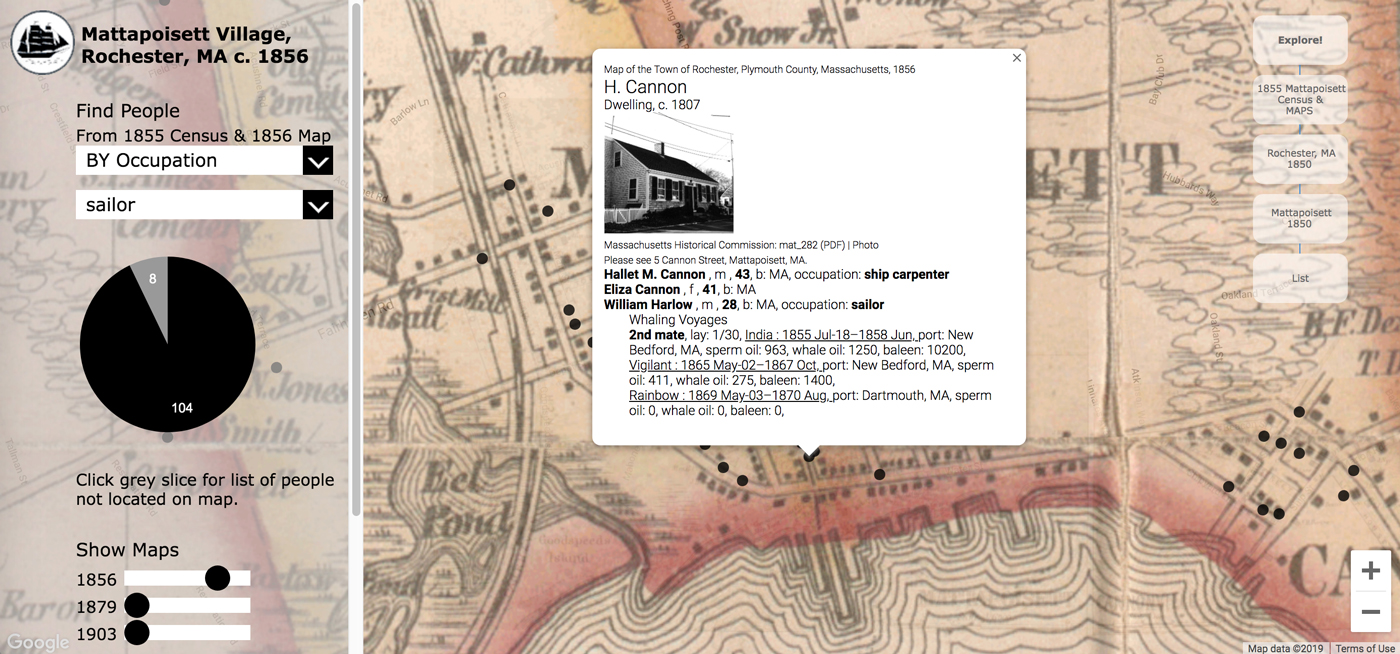
Through an interactive map focusing on village residents, visitors can explore Mattapoisett village c. 1855/1856. Clicking on the map reveals information about the residents, the whaling voyages residents crewed, historic buildings, and related Mattapoisett Museum collection records. Overlaying later town maps shows how the town changed between 1856 and 1903.
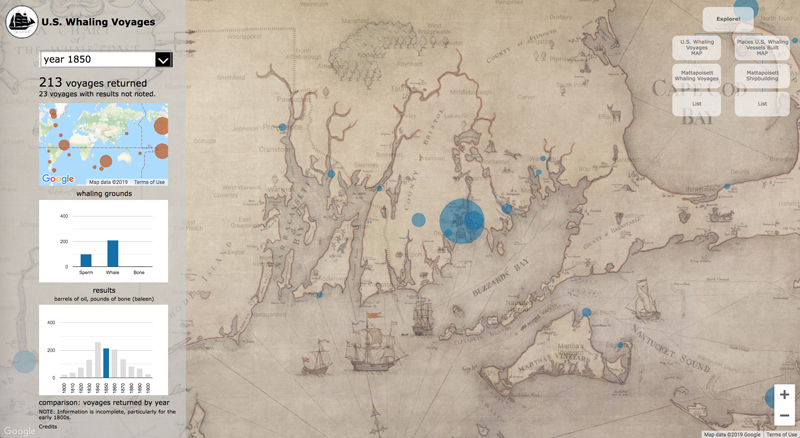
Visualizations summarize the growth of the U.S. whaling and Mattapoisett shipbuilding industries during the 1800s, document changes in occupations, and provide contextualized access to collection images.
The underlying microdata may be viewed online and downloaded.
Mattapoisett Museum: 2014, 2019
WhalingHistory.org has been greatly expanded in the past year to include whaling data from more countries, links to scanned documents online, and a new global search.
Whaling History has from its beginning displayed maps of more than 1,300 whaling voyages based on data from the American Offshore Whaling Logbook database. Maps are included in the new Global Search, making them easier to locate. Browse voyage maps →
We have added an Explore menu to offer new ways to dig into the Whaling History databases and to feature aspects of the data that might not otherwise be discovered. One of the first Explore topics is Women who went whaling, an opportunity to find voyages on which the master’s wife sailed.
This map represents the journey of the whaler Neptune (Mystic Seaport Museum O-LOG 23) of New London, Connecticut. Chronicling the ship’s voyage from October, 1840 – April, 1842, the map depicts the ship’s day-to-day events as it traveled to the South Atlantic and Indian Oceans as they were described in the ship’s logbook. View the active map →
Original content by: Allyse Zajac
This voyage of Neptune is American Offshore Whaling Voyage AV10372. Our database includes summary information about the voyage, the vessel and the master, Samuel Greene, Jr., as well as a crew list. In building her interactive voyage map, Allyse Zajac started with AOWL logbook data then added detail, encoded special events, and transcribed all of the complete logbook entries from the original logbook in the collections of Mystic Seaport Museum.
In the next phase of our project, we hope to take the data set from her project and use it to enhance the information on whalinghistory.org.
By Kerry Gathers
At its peak in the mid-19th century, whaling was a gigantic, global business that provided oil to light the streets and homes of Europe and America, and bone to make profitable consumer goods for sale around the world. The young United States dominated this industry, and for a time, whaling was the fifth largest sector of the American economy.
While stories of whaling drama, adventure, and violence are typically set at sea, this map aims to communicate the economic impact of whaling back in American ports, where sperm oil, whale oil, and whalebone landed and entered the market. For over 60 port cities and towns, this map reports the market values of whale products as they were returned to port from 1804 to 1876, illustrating the drastic ebbs and flows of the industry.
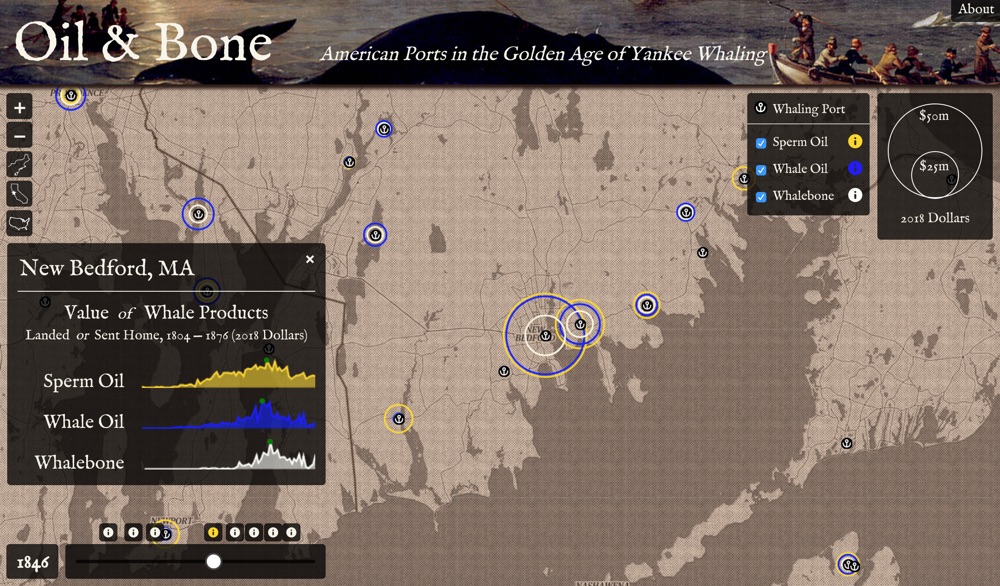
WhalingHistory.org is now hosting two important data sets documenting British whaling.
The databases contain voyage and crew information for the British Southern Whale Fishery, which operated from 1775 to 1859. The voyage database, which is primarily the work of A G E (Joe) Jones, documents the events of about 2550 voyages, whaling or sealing, to the south of Britain in over 930 different vessels. The crew database, which is primarily the work of Dale Chatwin, lists nearly 14,000 entries for men who sailed in the ships in the British Southern Whale Fishery.
For 350 years until the early 1960s the British were involved in several types of whaling. This involvement was divided into three distinct trades: the northern whale fishery between 1610 and 1914; the southern whale fishery or ‘south seas trade’ from 1775 to 1859; and the modern whaling trade, from 1904 to 1963. Each of these trades was distinguished by the geographical location in which it was undertaken, the types of whales pursued, and to some extent by the methods and techniques used to capture whales. The northern and southern whale fisheries were even differentiated and defined by law.
We are especially pleased to host the BSWF data because many American whalers also sailed from British ports in the years after the American Revolution. We are looking forward to making these connections explicit, linking records in the American Offshore Whaling databases with those in the British Southern Whale Fishery data.
WhalingHistory.org connects all things whaling for researchers, scholars, genealogists and enthusiasts
The New Bedford Whaling Museum and Mystic Seaport Museum have developed the world’s most comprehensive whaling history database and it is now available for all to use at whalinghistory.org. Researchers, genealogists, students, teachers, and history buffs alike will find it to be the most robust and useful repository of whaling history documentation and scholarship.
The data presented combines many sources including logbooks, journals, ship registers, newspapers, business papers, and custom house records. Users will be able to find and trace whaling voyages and ships to specific logbooks, as well as the list of crew members aboard most of the voyages. The foundational fabric of Whaling History features three databases that have been stitched together – the American Offshore Whaling Voyage (AOWV) database, the American Offshore Whaling Log database, and an extensive whaling crew list database. All data is open to the public and is downloadable for any researcher to use with other tools and systems.
The American Offshore Whaling Voyage (AOWV) database, which was spearheaded by Judith Lund, scholar and former curator at the New Bedford Whaling Museum, includes information about all known American offshore (or “pelagic”) whaling voyages from the 1700s to the 1920s. It does not include the modern factory ship voyages of the mid-20th century. Information is most complete for the 19th century. The voyages included in the database sailed from, or were under the registry of, what is now the United States.
Extensive records of American whaling in the form of daily entries in whaling voyage logbooks and contain a great deal of information about where and when the whalemen found whales. The second part of the database’s foundation is the American Offshore Whaling Log database, which includes information from 1,381 logbooks from American offshore whaling voyages between 1784 and 1920. These data were extracted from the original whaling logbooks during three separate scientific research projects, one conducted by Lieutenant Commander Matthew Fontaine Maury in the 1850s, the second conducted by Charles Haskins Townsend in the 1930s, and the third conducted by a team from the Census of Marine Life project led by Tim Denis Smith between 2000 and 2010. The data file includes 466,134 data records assembled in a common format suitable for spatial and temporal analysis of American whaling throughout the 19th century.
The third database that Whaling History is built from is extensive whaling voyage crew lists from more than 5,300 voyages. Crew lists for whaling voyages recorded at the customs houses in Fall River and Salem, Massachusetts and in New London, Connecticut have been compiled as part of various projects and from various sources over the years. Crew lists for New Bedford voyages have been compiled using records kept by the chaplains of the New Bedford Port Society from 1840 to the end of whaling in New Bedford. These crew lists are now in a single searchable, sortable database.
In the next phase of the Whaling History, museums and other institutions’ collection items will be able to be linked to the database, giving researchers the ability to see a robust and dynamic picture of whaling history and artifacts.
This map showing the spatial distribution of American Whaling and Whales in the 17th to 19th century was created using AOWL data. This and other maps are presented in:
Smith TD, Reeves RR, Josephson EA, Lund JN (2012) Spatial and Seasonal Distribution of American Whaling and Whales in the Age of Sail. PLoS ONE 7(4): e34905.
https://doi.org/10.1371/journal.pone.0034905
American whalemen sailed out of ports on the east coast of the United States and in California from the 18th to early 20th centuries, searching for whales throughout the world’s oceans. From an initial focus on sperm whales (Physeter macrocephalus) and right whales (Eubalaena spp.), the array of targeted whales expanded to include bowhead whales (Balaena mysticetus), humpback whales (Megaptera novaeangliae), and gray whales (Eschrichtius robustus). Extensive records of American whaling in the form of daily entries in whaling voyage logbooks contain a great deal of information about where and when the whalemen found whales. We plotted daily locations where the several species of whales were observed, both those caught and those sighted but not caught, on world maps to illustrate the spatial and temporal distribution of both American whaling activity and the whales. The patterns shown on the maps provide the basis for various inferences concerning the historical distribution of the target whales prior to and during this episode of global whaling.
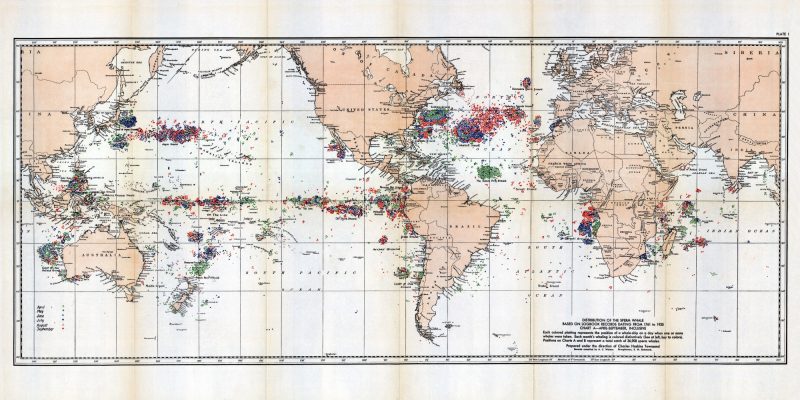
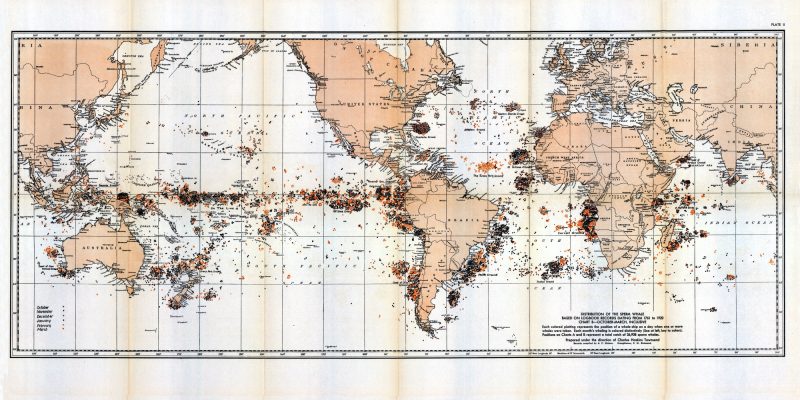
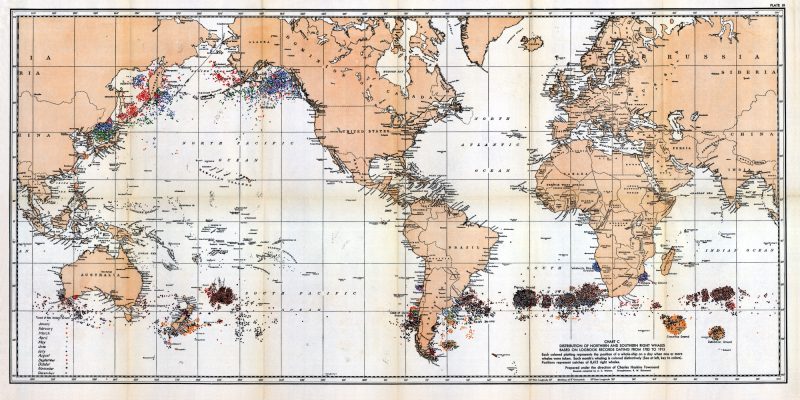
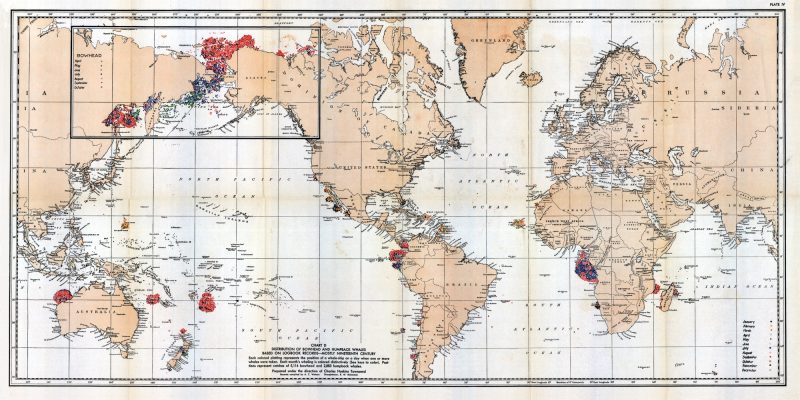
From Townsend CH (1935) The distribution of certain whales as shown by logbook records of American whaleships. 19. Zoologica (NY): : 1–50+6 Charts.
For a dataset that corresponds in part to these charts, visit Townsend’s Logbook Data →
For more information and chart scans, visit WCS Canada →